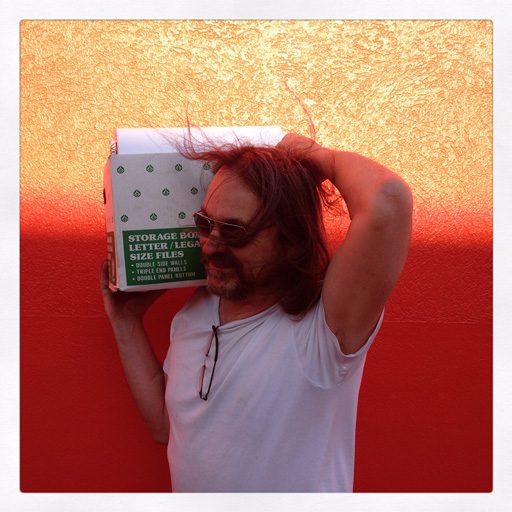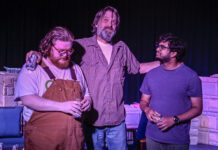
Photo courtesy Joe Andoe.
[dropcap]Joe[/dropcap] Andoe no longer lives in Tulsa, but a little piece of Tulsa resides in everything he paints.
Take one of his more recent exhibits, Super Highway, for example: Andoe used images from Google Street View as a direct inspiration for characteristically stark landscape paintings of places he remembered from his past, growing up in the 1960s and ‘70s in an east Tulsa neighborhood that never seemed far from undeveloped fields full of horses.
This particular approach to the Internet – using it “like a periscope to look at these old places that haven’t changed much,” he says, save perhaps for the broadband cables that convey the images themselves – is merely the latest iteration of an artistic process that seems to be perpetually gazing back into a specific time and an even more specific geographical location.
“Tulsa is still my home, even though I have lived in New York for 32 years,” he says.
But the path from the lonesome roads of east Tulsa to the fashionable art galleries of the Lower East Side was never an easy one, nor was it always paved with the most sober of intentions. Andoe’s 2007 memoir, Jubilee City, details a life of drug- and alcohol-related experiences, relationships with beautiful but emotionally unstable women and a tendency toward self-destruction which, more than once, came close to costing him his career, but which he has since succeeded in conquering.
Born in 1955, Andoe began drawing extensively early on – a habit shared by most kids, but with Andoe, it gradually took the shape of something greater, persisting as childhood gave way to the teens against a backdrop of sex, drugs, and rock ‘n’ roll.
[pullquote]My story was just so much more interesting than some kid whose parents drove him down the Merritt Parkway and set him up in a loft in Tribeca,” he says. “I was blown away to meet guys who had never held a shovel or even knew how to drive.[/pullquote]Andoe’s book recalls a pre-digital era when young adults seemed to live more in the present moment, determined to find whatever forms of physical pleasure life had to offer them. He writes of driving to the outskirts of town with an older friend to get drunk on cheap wine at age 14, concluding, “At last I had mastered the low art of coming unmoored.”
A later experience, hitchhiking from Tulsa to the Mexican border near the end of his high school days, feels like something out of Jack Kerouac’s On the Road.
“I remember that I was lucid and in the moment, and how flat and warm I-35 was against my back, and how big, wide, and deep the south Texas sky was and how I had never seen so many stars, and how I had never been so free,” he writes.
Meanwhile, Andoe’s family and friends and classmates continued to respond favorably to his drawings – all the way up to his time at Tulsa Junior College, where he initially majored in agricultural business with the intent of opening a feed store. Faring poorly in those classes, but wanting to stay in school because he had a new girlfriend there, Andoe changed his major to art.
A significant moment occurred when his art teacher hung up students’ still lifes in the classroom, and Andoe did not see his among them. He knew something was going on, he says.
“I asked why he didn’t hang my still life up, and he said it stood out too much,” Andoe recalls.
From there it was on to the University of Oklahoma’s art school. In Norman he met the woman with whom he would share a troubled marriage and relocate to New York City, where further misadventures lay in store, including tragicomically abortive attempts to establish a home in nearby Jersey City.
The thought of being ashamed of his origins never occurred to him, he says; in fact, his roots played to his advantage. There are even points in his literary self-portrait where he refers to himself in the third person as a “cowboy.”
“My story was just so much more interesting than some kid whose parents drove him down the Merritt Parkway and set him up in a loft in Tribeca,” he says. “I was blown away to meet guys who had never held a shovel or even knew how to drive.”
His reception was, at least for a time, less favorable in his own state. Back in Tulsa, years after he had accumulated a body of work and made a name for himself, the Philbrook Museum of Art refused a gift of one of his paintings. He attributes this to a lack of willingness to accept artists from lower socioeconomic backgrounds.
[pullquote]I know what it’s like to own things. I know what it’s like to spend money. I know what it’s like to buy cars by impulse. And that’s all overrated.[/pullquote]“I guess it would have seemed weird to me, too, once upon a time to see a guy from east Tulsa calling himself an artist,” he says.
But he thinks that Oklahoma is changing for the better as far as those attitudes are concerned. His work eventually appeared at Philbrook as part of a traveling show comprised of still lifes from New York’s Metropolitan Museum of Art.
So goes the upward trajectory of Andoe’s life story – and if the cinematic potential of that story has yet to be realized, it is not necessarily for lack of effort. A condensed version of the book nearly saw life as a movie – not so much A Memoir at Full Speed as A Memoir on Crack, Andoe says – but, after various fits and starts, the project failed to reach fruition.
Fellow Tulsa native Larry Clark was slated to direct, he says.
“He got me to write the screenplay so we didn’t lose control of the story,” he says. “Just like a couple of Okies, we got the same lawyer, a Hollywood lawyer that we were sharing, so we were on the same team, you know? But it just didn’t happen.”
Andoe is a man of the 20th century who made it, against improbable odds, to the 21st with body intact and mind expanded. He is also an artist who gained international recognition through sheer force of creative will – a testament to the idea that, even in a crowded field like professional painting, success may be achieved on merit alone, and not just as a result of knowing the right people or being born into the right milieu. Viewed from a certain angle, his life assumes Horatio Alger-esque dimensions.
“Nobody really gave anything to me,” he says. “I never expected it. Nobody ever gave me a thing besides my folks.”
Now approaching age 60, he is in a position to look back as one of the lucky ones. A question naturally arises as to what advice he might dispense to young, aspiring artists.
“Don’t do it,” he says, tongue at least partly in cheek, and knowing full well that people will ultimately do what they want, that any valid art inside of a person will find its way to expression.
What makes him happy now, he says, are the simpler things – seeing his children, talking to his friends, working.
“I know what it’s like to own things. I know what it’s like to spend money. I know what it’s like to buy cars by impulse. And that’s all overrated,” he says.
“Maybe that’s a piece of advice in itself,” I suggest.
“I guess so,” he replies, toward the end of a conversation in which no attempt had been made to hide his Oklahoma accent.



























